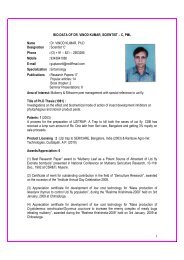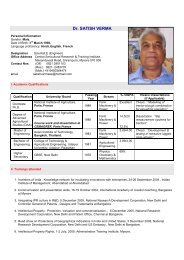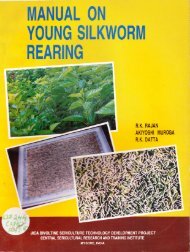Silkworm
A Treatise on the Acid Treatment of Silkworm Eggs - Central ...
A Treatise on the Acid Treatment of Silkworm Eggs - Central ...
You also want an ePaper? Increase the reach of your titles
YUMPU automatically turns print PDFs into web optimized ePapers that Google loves.
Correct age of silkworm eggs for acid treatment<br />
The sensitivity of HCltreatment is very much dependent on the age ol the eggs. There is a critical<br />
period in the embryonic morphogenesis Ouiing which the treatment is most effective. The ef{ectiveness<br />
of treatment is reftected in hatchabitity.<br />
Fertilization is external in silkworm. The process of syngamy i.e. the fusion of sperm nucleus and<br />
eggnucleustakesplaceabout2hoursalterthedepositionottl.'eeggsbythemothermoth.<br />
Thecleavage<br />
process occurs between 3 to 1 0 hours after oviposition with blastoderm ippearing between 10th and 15th<br />
hour and lhe lurther embryonic differentiation lrorn 15th hour onwards iat ovipdsition uno pr"rr;il;<br />
temperature of 25.C and RH 75 t S%).<br />
one to ten hour old eggs are highly sensitive and ii treated, the treatment turns out ine{fective as<br />
many of them die at the early developmental stage leading to a poor hatching performance. lf the<br />
treatment is conducted after 15 hrs. of oviposiiion, effective nitctring can be obtained. However, the best<br />
lime for acid treatment falls between 20 and 24 hrs. after ovlposition, when the embryo has reached the<br />
germband stage and is in the process of becoming an independent embryo. Externally no symptoms are<br />
noticeable, as the eggs still present the original egg colour, with no morphological changes.<br />
While these developmental stages are lrue to ideal situations, the pace of embryonic development<br />
is always regulated by the oviposition and preservation temperatures. Higher tre temperature, faster is<br />
the rate of developmelt and lower the temperature slower the embryoniCdevelopment. ln light of this<br />
precarious strategy, suitable time for conductinE acid treatment has to be necessarily clecided in relation<br />
to oviposition/preservation temperature. The oviposition temperature and appropriate time for acid<br />
treatment are given in Table 6.<br />
TABLE 6 Oviposition and preser\ration ten'lperature and suitable time for acid treatnrent<br />
I emperature trom ovtposttton to commencement of treatment Appropiate time for acid treatrnent (Age of the egg in hours)<br />
20+ 1"9<br />
25-35<br />
. 24 +1.C<br />
2A-24<br />
27 + 1"C<br />
17-22<br />
29 + 1"C<br />
15-20<br />
l<br />
r<br />
The above information serves as a broad guideline to decide the time factor. However, in cases<br />
where violent temperature fluctuations are noticed during oviposition and subsequent handling operations,<br />
colour of the egEs may be taken into account to monitor the treatment time.<br />
Freshly laid eggs are generally pale yellow or dark yellow in cotour. ln diapausing lerlitized eggs,<br />
after a certain stage of development, the eggs begin to acquire a brownish colour. This is due to the<br />
appearance of a specilic pigment known as Ommochrome, inthe serosal cells, indicating the first phase<br />
of diapause initiation. lt is always safe to carry out the treatment before this colour manifestation.<br />
However, if the eggs begin to present a faint brownish or pinkish tinge, they are immed iately treated without<br />
anylurtherdelay. Suchapracticehastobediscouragedasdelayedtreatmentsmayteadtoirregularand<br />
ineffective hatching.<br />
Eggstreatedafter4Shoursofovipositionresultin badandirregularhatching,whiletheeggstreated<br />
after 3 days after oviposition will have less than 10% hatching.<br />
14




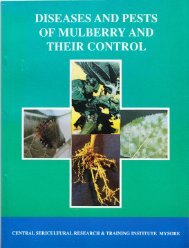

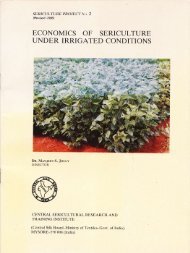
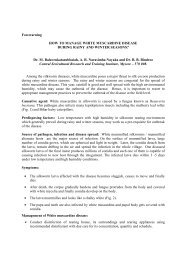
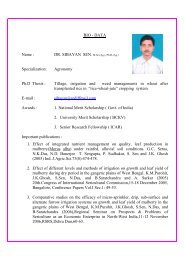
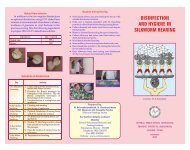
![E}A]\GALORE](https://img.yumpu.com/54052619/1/190x260/eagalore.jpg?quality=85)

